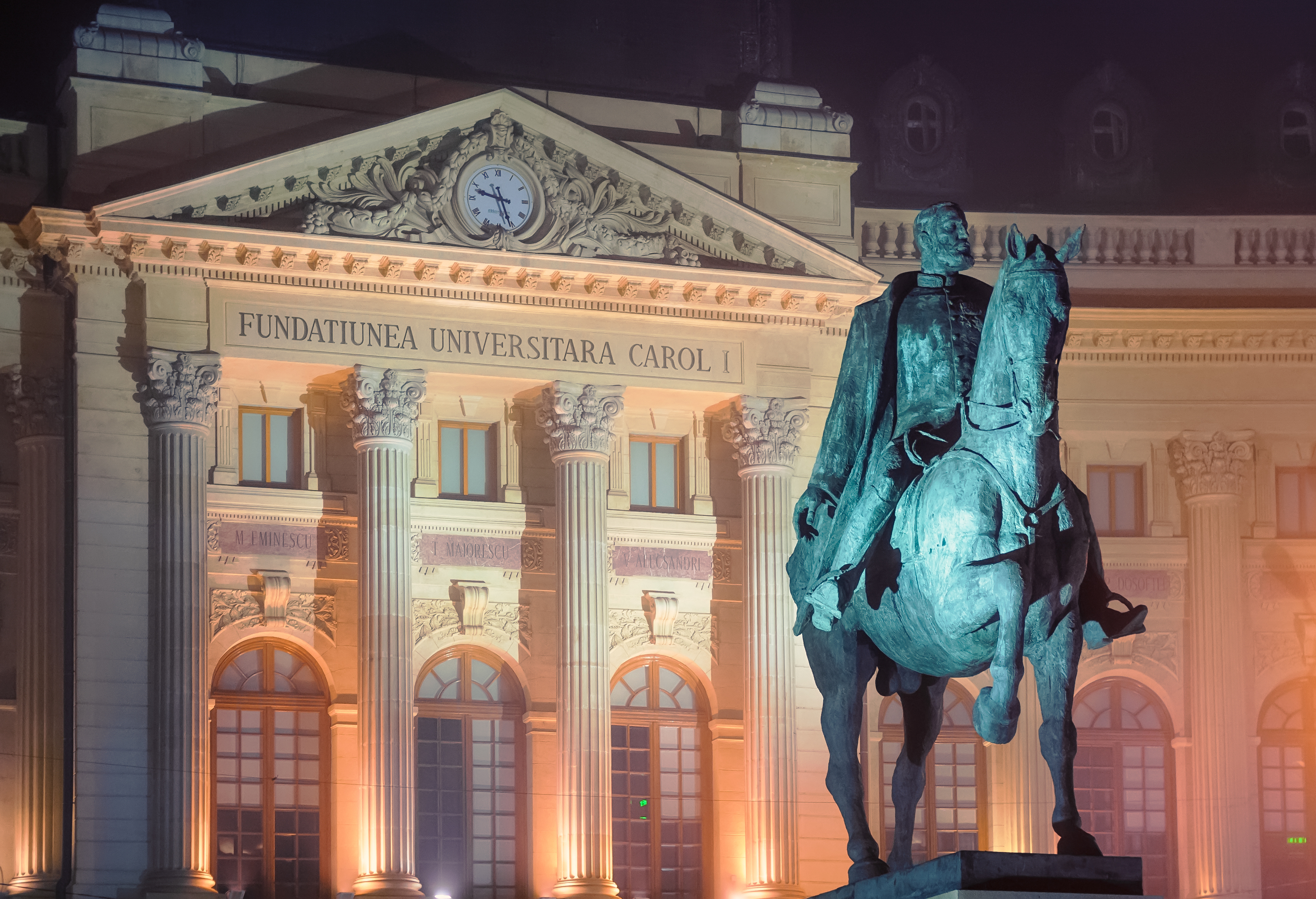|
Bucharest Astronomical Observatory
The Astronomical Institute of the Romanian Academy was created in 1990 with the union of three astronomical observatories: the Bucharest Astronomical Observatory, the Cluj Observatory and the Timișoara Observatory. The Bucharest astronomical observatory History The astronomical observatory of Bucharest was established on April 1, 1908, by decree of the Minister of Education and Religious Affairs, Spiru Haret. Nicolae Coculescu was appointed first director of the observatory. Construction work began in 1910 on Filaret Hill in Carol Park (in the south of the city) and lasted two years. The astronomical observatory included a main building for scientific laboratories and administrative offices and a dome for an 11.5-meter telescope. Together with the astronomical observatory, a meteorological observatory was created. In 1920, the meteorological observatory was administratively separated from the astronomical observatory. In 1945, the astronomical observatory came under the coordin ... [...More Info...] [...Related Items...] OR: [Wikipedia] [Google] [Baidu] |
Spiru Haret
Spiru C. Haret (; 15 February 1851 – 17 December 1912) was a Romanian mathematician, astronomer, and politician. He made a fundamental contribution to the ''n''-body problem in celestial mechanics by proving that using a third degree approximation for the disturbing forces implies instability of the major axes of the orbits, and by introducing the concept of ''secular perturbations'' in relation to this. As a politician, during his three terms as Minister of Education, Haret ran deep reforms, building the modern Romanian education system. He was made a full member of the Romanian Academy in 1892. He also founded the Bucharest Astronomical Observatory, appointing as its first director. The crater Haret on the Moon is named after him. Life Haret was born in Iași, Moldavia, to Constantin and Smaranda Haret, who were of Armenian origin. His baptismal record listed his name as Spiridon Haret. He started his studies in Dorohoi Iași, and in 1862 moved to Saint Sava High ... [...More Info...] [...Related Items...] OR: [Wikipedia] [Google] [Baidu] |
Nicolae Coculescu
{{disambig ...
Nicolae may refer to: * Nicolae (name), an Aromanian and Romanian name * ''Nicolae'' (novel), a 1997 novel See also *Nicolai (other) *Nicolao Nicolao is an Italian given name and a surname. It may refer to the following: Given name *Nicolao Civitali (1482 – after 1560), Italian sculptor and architect *Nicolao Colletti (18th century), Italian mathematician *Nicolao Dorati (c. 1513 – 1 ... [...More Info...] [...Related Items...] OR: [Wikipedia] [Google] [Baidu] |
Carol Park
Carol I Park () is a public park in Bucharest, Romania, named after King Carol I of Romania. A French garden located in the southern-central area of Bucharest, partly on Filaret Hill, originally capable of hosting various exhibitions, it suffered considerable modifications during the communist regime, including a name change to ''Parcul Libertății'' (Liberty Park). The park has officially been listed as a historical monument since 2004. Administration of the park is undertaken mostly by the Bucharest City Hall, whereas monuments are in the care of the Ministry of Culture and Religious Affairs. History The park was designed by French landscape artist in 1900 on Filaret Hill, under the supervision of Constantin Istrati, then president of the Romanian Academy. It was inaugurated in 1906, on the 40th anniversary of the coronation of King Carol I. The park had an initial surface area of , including the Lake Filaret. It hosted the 1906 Bucharest Exhibition, and included ma ... [...More Info...] [...Related Items...] OR: [Wikipedia] [Google] [Baidu] |
University Of Bucharest
The University of Bucharest (UB) () is a public university, public research university in Bucharest, Romania. It was founded in its current form on by a decree of Prince Alexandru Ioan Cuza to convert the former Princely Academy of Bucharest, Princely Academy into the current University of Bucharest, making it one of the oldest Romanian universities. It is one of the five members of the ''Universitaria Consortium'' (a group of elite Romanian universities). The University of Bucharest offers study programmes in Romanian and English and is classified as an ''advanced research and education university'' by the Ministry of Education and Scientific Research (Romania), Ministry of Education. History The University of Bucharest was founded by the Decree no. 765 of 4 July 1864 by Alexandru Ioan Cuza and is a leading academic centre and a significant point of reference in society. The University of Bucharest is rich in history and has been actively contributing to the development a ... [...More Info...] [...Related Items...] OR: [Wikipedia] [Google] [Baidu] |
Romanian Academy
The Romanian Academy ( ) is a cultural forum founded in Bucharest, Romania, in 1866. It covers the scientific, artistic and literary domains. The academy has 181 active members who are elected for life. According to its bylaws, the academy's main goals are the cultivation of Romanian language and Romanian literature, the study of the national history of Romania and research into major scientific domains. Some of the academy's fundamental projects are the Romanian language dictionary ('' Dicționarul explicativ al limbii române''), the dictionary of Romanian literature, and the treatise on the history of the Romanian people. History On the initiative of C. A. Rosetti, the Academy was founded on April 1, 1866, as ''Societatea Literară Română''. The founding members were illustrious members of the Romanian society of the age. The name changed to ''Societatea Academică Romînă'' in 1867, and finally to ''Academia Română'' in 1879, during the reign of Carol I. The foun ... [...More Info...] [...Related Items...] OR: [Wikipedia] [Google] [Baidu] |
Planetarium
A planetarium (: planetariums or planetaria) is a theatre built primarily for presenting educational and entertaining shows about astronomy and the night sky, or for training in celestial navigation. A dominant feature of most planetariums is the large dome-shaped projection screen onto which scenes of stars, planets, and other celestial objects can be made to appear and move realistically to simulate their motion. The projection can be created in various ways, such as a star ball, slide projector, video, fulldome projector systems, and lasers. Typical systems can be set to simulate the sky at any point in time, past or present, and often to depict the night sky as it would appear from any point of latitude on Earth. Planetaria range in size from the 37 meter dome in St. Petersburg, Russia (called "Planetarium No 1") to three-meter inflatable portable domes where attendees sit on the floor. The largest planetarium in the Western Hemisphere is the Jennifer Chalsty Planetariu ... [...More Info...] [...Related Items...] OR: [Wikipedia] [Google] [Baidu] |
Constantin C
Constantin is an Aromanian, Megleno-Romanian and Romanian male given name. It can also be a surname. For a list of notable people called Constantin, see Constantine (name). See also * Constantine (name) * Konstantin The first name Konstantin () is a derivation from the Latin name '' Constantinus'' ( Constantine) in some European languages, such as Bulgarian, Russian, Estonian and German. As a Christian given name, it refers to the memory of the Roman empe ... References {{Reflist Aromanian masculine given names Megleno-Romanian masculine given names Romanian masculine given names Masculine given names Romanian-language surnames ... [...More Info...] [...Related Items...] OR: [Wikipedia] [Google] [Baidu] |
Gheorghe Demetrescu
Gheorghe is a Romanian and Aromanian given name and surname. It is a variant of George, also a name in Romanian but with soft Gs. It may refer to: Given name * Gheorghe Adamescu (1869–1942), Romanian literary historian and bibliographer * Gheorghe Albu (1909–1974), Romanian footballer * Gheorghe Alexandrescu * Gheorghe Andriev (born 1968), Romanian sprint canoeist * Gheorghe Apostol (1913–2010), Romanian politician, deputy Prime Minister of Romania and a former leader of the Communist Party * Gheorghe Apostoleanu (1832–1895), Romanian politician * Gheorghe Argeșanu (1883–1940), Romanian general * Gheorghe Arsenescu (1907–1962), Romanian Army officer * Gheorghe Asachi (1788–1869), Moldavian polymath * Gheorghe Băgulescu (1886–1963), Romanian general * Gheorghe Balș (1868–1934), Romanian engineer, architect and art historian * Gheorghe Bănciulescu (1898–1935), Romanian aviator * Gheorghe Banu (1889–1957), Romanian eugenicist and politician * Gheorghe B ... [...More Info...] [...Related Items...] OR: [Wikipedia] [Google] [Baidu] |
Constantin Drâmbă
Constantin is an Aromanian, Megleno-Romanian and Romanian male given name. It can also be a surname. For a list of notable people called Constantin, see Constantine (name). See also * Constantine (name) * Konstantin The first name Konstantin () is a derivation from the Latin name '' Constantinus'' ( Constantine) in some European languages, such as Bulgarian, Russian, Estonian and German. As a Christian given name, it refers to the memory of the Roman empe ... References {{Reflist Aromanian masculine given names Megleno-Romanian masculine given names Romanian masculine given names Masculine given names Romanian-language surnames ... [...More Info...] [...Related Items...] OR: [Wikipedia] [Google] [Baidu] |
Bucharest Observatory "Admiral Vasile Urseanu"
The Bucharest Observatory is an astronomical observatory located at no. 21 Lascăr Catargiu Boulevard, Bucharest, Romania. It is Bucharest's only observatory open to the public. History The observatory was built between 1908 and 1910, for Admiral Vasile Urseanu, president of the ''Romanian Astronomical Society "Camille Flammarion"''. It was equipped with a 150 mm diameter Zeiss telescope with a focal length of 2.7 meters; the telescope was the third largest in Romania at the time. Ion D. Berindey was the architect. The observatory founded by Urseanu was frequented by amateur astronomers; professional researchers worked at the Bucharest Astronomical Observatory, founded by Nicolae Coculescu and located on ''Filaret Hill'' in Carol Park. Following the death of Admiral Urseanu in 1926, the telescope was dismantled and stored in the basement of the building. In 1933, Urseanu's widow donated the building to the municipality of Bucharest, which used it as a pinacotheca. In 194 ... [...More Info...] [...Related Items...] OR: [Wikipedia] [Google] [Baidu] |


